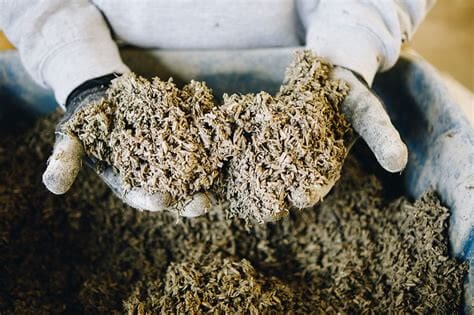In our never-ending quest on the benefits of all things Cannabis (You know, that Glorious Green plant people are so afraid of?), we thought it would be great to expound on hemp-lime otherwise known as Hempcrete.
What is Hempcrete?
Hempcrete, or “hemp-lime”, is a medium-density natural insulation material produced by mixing the inner woody core of the stalk known as the hurd with a natural, lime-based binder, and water. It is used as a highly insulative wall material that is carbon-negative, natural, and lightweight. It provides highly efficient temperature and moisture control. It is formable, dynamic, and one-seventh the weight of concrete. It also cures within hours. The combination of hemp hurd with a lime binder has extraordinary thermal properties, which means that when heat is passed through a material, it changes shape. In general, when the material is heated, it expands. This property of the material is known as “thermal expansion”, where there can be a change in the area, volume, and shape of the material. Due to its lime binder, hempcrete provides thermal mass, as well as insulation. The two work together to produce a superior thermal performance. Also, by changing the ratio of lime binder to hemp, the strength and thermal properties of the hempcrete will vary, allowing it to be used as breathable insulation for many building products such as in solid floors, walls, and roofs. It can be used in new builds, renovation projects, and many things in between.

Due to its ability to absorb and release moisture from the interior air, hempcrete can create healthy buildings and homes. The absorption helps to regulate internal humidity which, in turn, prevents condensation and a damp environment that can lead to toxic black mold growth. Hempcrete and the finishes applied to it are ”breathable”. This maximizes the thermal performance and increases the longevity of the building’s fabric. By providing excellent thermal and acoustic properties in airtight structures, hempcrete has proven to be a very unique building material.
The Advantages of Hempcrete
- Hempcrete is highly insulating and airtight which makes it ideal for meeting today’s building standards.
- Hempcrete also has thermal mass. This means that hempcrete buildings change temperature more slowly and have the ability to reduced energy demands for heating and cooling.
- In hempcrete, insulation and thermal mass work together.
- Hempcrete is natural, and breathable, creating healthy indoor environments, and protecting the building’s fabric.
- Hempcrete materials can be produced locally with hemp having the ability to be grown almost anywhere in the world and the abundance of limestone accordingly.
- Hemp transforms CO2 during its growth by capturing carbon and releasing oxygen. Using hemp in construction locks away carbon for the lifetime of the building.
- Hemp can be grown in rotation with food crops to improve the soil and reduce weeds, it does not require chemical fertilizers in its cultivation and there is no need for pesticides or insecticides.
- The hemp hurd used in hempcrete is a low-value waste product of the hemp industry.
What is the difference between hempcrete and concrete?

As we know, concrete is a material used to create foundations and load-bearing structures. It’s heavy, cold to the touch, and has zero insulative qualities.
On the other hand, hempcrete is extremely lightweight. As stated above, it is one-seventh the weight of concrete. It is non-load bearing and can best be described as a masonry infill material with a porous, airy composition. It is currently in the spotlight for several reasons such as:
It’s a high-performance insulator, able to regulate the moisture content of the house. This can provide a sense of comfort and relief from allergies.
It is carbon-negative and can mitigate the carbon footprint of the entire house-building process.
The Binding
We’ve already discussed the binder is what binds the hemp shiv into a solid mass. The binder consists of either hydrated lime or natural hydraulic lime. Hydrated lime (or air lime) has no impurities and is made by kiln-firing limestone. The firing process removes the carbon molecules from the limestone and converts it into a dry powder. When you want to use lime as a binder or mortar, you re-introduce carbon dioxide. This essentially converts the lime back into limestone as it absorbs the CO2. This is what’s known as the carbon cycle.
The other lime, hydraulic lime, is also kiln-fired using the same process. The difference? Hydraulic lime has added or existing impurities known as pozzolans. Since hemp hurd has a high silica content, and interestingly enough, silica just so happens to be a pozzolan, the actual hemp serves as not only the insulator, but also increases the set speed and strength of the lime.
Have I ever mentioned what a “Glorious Green” plant hemp is?
In the end, there are many benefits of using a natural lime mortar as opposed to modern cement. One only needs to look at ancient structures (Roman architecture) to see the benefits of a binder that is more flexible, breathable, and can stand the test of time.

